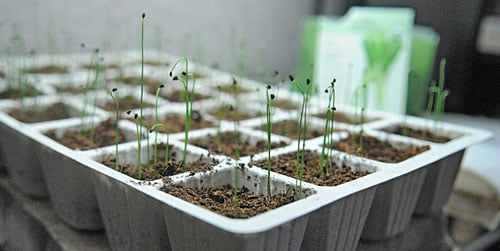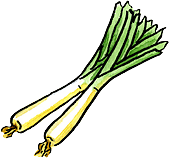Leeks
 Leek seedlings growing under lights. Most varieties should be planted 10 to 12 weeks before the last frost date in your area.
Leek seedlings growing under lights. Most varieties should be planted 10 to 12 weeks before the last frost date in your area.
Leeks are easy to grow. They require little to no attention and are generally pest-free. In the kitchen, they can be substituted for onions and, unlike onions, can be chopped and frozen for use in the winter after you run out of your own onions.
There are two types of leeks: non-hardy or early leeks that reach full size in 50 to 75 days, and the hardy types that take 100 days or more The hardy ones are good for storage and in many places they can even be left right in the ground over the winter, especially if you mulch them with leaves or straw. Though leeks may survive the entire winter, know that when spring comes they will quickly turn leathery and tough.
Prepare the soil for leeks by lightening it up with lots of compost. There's no need for much fertilizer. Grocery store leeks have long white stems because the stems have been buried in soil or sand to prevent light from turning them green. You can do this, too. The reward is longer, more useable stems.
To blanch leeks, plant each seedling at the bottom of a hole that's about 6" deep. Fill in around the base of the leek as it gradually gets taller. By the end of the season, the bottom of each plant will have a 6-8" section that's tender and white.
Like onions, leeks started indoors need to be planted early: 10 to 12 weeks before the last frost date. You can sow the seeds closely together in an open flat. To encourage the plants to develop strong roots and a stocky stature, use scissors to give them weekly haircuts. Cutting off all but the bottom 2" of the plant will help force the plant's energy back into the roots. Leeks can be planted outdoors about the time of the last spring frost, though they will survive light frosts even when young — and heavy frosts in the fall.
The closer together you plant leeks, the smaller they will be. Commercial growers usually place them about 6-8" apart and don't thin them. A good technique for home gardeners is to plant them just 2-3" apart, and achieve proper spacing by harvesting baby leeks as you need them. These young leeks are a good substitute for onions in the early summer kitchen.
It is good to rotate the location of your leeks from year to year, avoiding places where onions or garlic have grown, because the same pests and diseases can affect your leeks.
Last updated: 03/21/2022
Print this Article:
Get the Dirt
Stay up to date on new articles and advice. Please fill out the information below.
